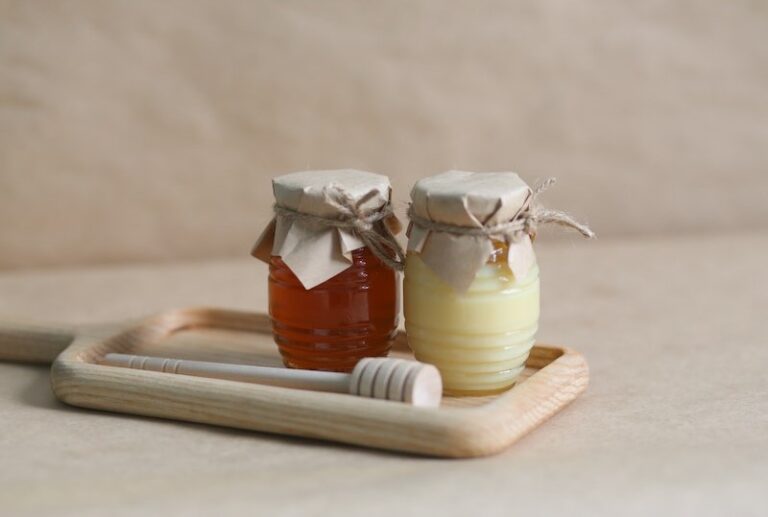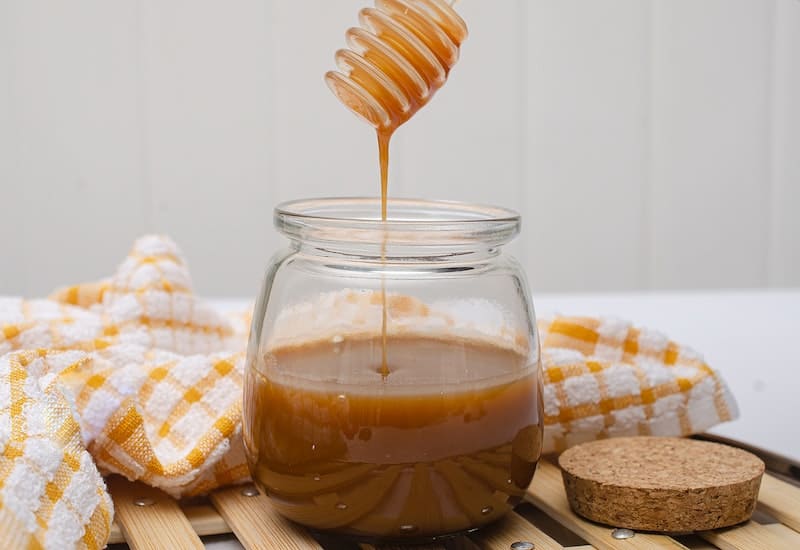Hey there, honey lovers! Are you tired of finding your favorite golden jar all clumpy and crystalized? Well, you're not alone. Crystallization is a natural process that happens to honey, but don’t freak out—there are ways to prevent it. If you’ve ever wondered how to keep honey from crystallizing, you’ve come to the right place. This guide will spill all the secrets to keeping your honey as smooth and delicious as the day you bought it.
Honey is one of nature’s sweetest gifts, and we all know how amazing it tastes in tea, on toast, or drizzled over yogurt. But let's be real—nobody wants to deal with a jar of grainy honey. The good news? Crystallization doesn't mean your honey has gone bad. In fact, it's a sign of pure, unfiltered honey. However, if you're looking for ways to keep it liquid and luscious, we’ve got you covered.
So, grab your favorite mug of tea (with honey, of course), and let’s dive into this sweet adventure. We’ll cover everything from the science behind crystallization to practical tips that will help you enjoy your honey for longer. Let’s get started!
Read also:Khyati Shree Nude Debunking The Myths And Setting The Record Straight
Table of Contents
- What is Honey Crystallization?
- Why Does Honey Crystallize?
- How to Prevent Honey from Crystallizing
- Storage Tips for Honey
- Using Heated Methods to Preserve Honey
- Choosing the Right Honey
- Common Myths About Honey Crystallization
- How to Fix Crystallized Honey
- Health Benefits of Honey
- Final Thoughts on Keeping Honey Liquid
What is Honey Crystallization?
Honey crystallization is basically when the natural sugars in honey start to solidify over time. This process is completely normal and doesn’t mean your honey has gone bad. In fact, crystallized honey is still perfectly good to eat—it just looks a little different. The texture might change, but the flavor stays the same.
So, what exactly happens during crystallization? Well, honey contains a lot of glucose, which is less soluble than fructose. Over time, the glucose starts to separate from the water in the honey and forms tiny crystals. These crystals grow and spread throughout the jar, turning the honey into a thicker, more granular consistency.
Is Crystallized Honey Safe to Eat?
Absolutely! Crystallized honey is totally safe to eat. In fact, some people even prefer it because it’s easier to spread on toast or mix into recipes. The only downside is that it might not be as smooth and pourable as liquid honey. But hey, if you’re okay with a little texture, there’s no reason to stress about it.
Why Does Honey Crystallize?
Now that we know what crystallization is, let’s talk about why it happens. There are a few factors that can influence how quickly your honey crystallizes:
- Glucose Content: Honey with higher glucose levels tends to crystallize faster. Different types of honey have varying glucose-to-fructose ratios, so some will crystallize more quickly than others.
- Temperature: Cold temperatures can speed up the crystallization process. That’s why it’s important to store your honey in a warm, stable environment.
- Moisture Content: Honey with higher water content is more prone to crystallization. Raw, unfiltered honey often has more moisture, which can lead to faster crystallization.
- Storage Conditions: If your honey is exposed to air or temperature fluctuations, it’s more likely to crystallize. Proper storage is key to keeping your honey liquid.
So, if you want to keep your honey smooth and pourable, you’ll need to pay attention to these factors. Don’t worry—we’ll cover some tips on how to do that later!
How to Prevent Honey from Crystallizing
If you’re determined to keep your honey liquid, there are several things you can do. Here are some of the best ways to prevent crystallization:
Read also:Discover The World Of Diva Flawless Onlyfans Videos
1. Store Honey Properly
Proper storage is the first line of defense against crystallization. Always keep your honey in an airtight container to prevent moisture from getting in. And make sure to store it in a cool, dry place away from direct sunlight.
2. Use the Right Container
The type of container you use can also make a difference. Glass jars are the best option because they don’t react with the honey and help maintain its quality. Avoid plastic containers if you can—they’re more likely to let air in, which can accelerate crystallization.
3. Keep It Warm
Temperature plays a big role in honey crystallization. If you live in a cold climate, consider storing your honey in a warmer part of your kitchen, like a pantry or cupboard. Just don’t overdo it—excessive heat can ruin the flavor and nutritional value of your honey.
Storage Tips for Honey
Here are some additional storage tips to help you keep your honey fresh and liquid:
- Store honey in a dark, dry place to protect it from sunlight and moisture.
- Keep the lid tightly sealed to prevent air from getting inside the jar.
- Avoid refrigerating honey—it will crystallize much faster in the fridge.
- Consider using a honey dispenser or squeeze bottle for easy pouring and less exposure to air.
By following these tips, you can significantly slow down the crystallization process and enjoy your honey for longer.
Using Heated Methods to Preserve Honey
If you’re really serious about preventing crystallization, you might want to try heating your honey. This can help dissolve any existing crystals and keep the honey liquid for longer. Here’s how to do it:
- Fill a pot with warm water and place your honey jar (with the lid off) in the water.
- Let the honey sit in the warm water for about 10-15 minutes, or until the crystals dissolve.
- Once the honey is smooth again, remove it from the water and let it cool before sealing the jar.
Be careful not to overheat the honey—it should never exceed 120°F (49°C), as this can damage its natural enzymes and flavor.
Choosing the Right Honey
Not all honey is created equal. If you want to minimize crystallization, you’ll need to choose the right type of honey. Here are a few things to look for:
- Monofloral Honey: Honey made from a single flower source, like clover or acacia, tends to crystallize more slowly than polyfloral honey.
- Pasteurized Honey: Pasteurized honey has been heated to kill any yeast or bacteria, which can help prevent crystallization. However, it may also reduce the nutritional benefits of the honey.
- Filtered Honey: Filtered honey has fewer particles and impurities, which can slow down the crystallization process.
Ultimately, the choice is yours. Just remember that raw, unfiltered honey is often more nutritious, even if it crystallizes faster.
Common Myths About Honey Crystallization
There are a lot of misconceptions out there about honey crystallization. Let’s clear up some of the most common myths:
- Myth #1: Crystallized honey is spoiled. False! Crystallized honey is perfectly safe to eat and still retains all its nutritional benefits.
- Myth #2: Only low-quality honey crystallizes. Wrong! Even the highest-quality honey can crystallize—it’s a natural process that happens to all honey eventually.
- Myth #3: Heating honey ruins it. Not necessarily. While excessive heat can damage honey, gentle warming can help dissolve crystals without harming its properties.
So, don’t let these myths scare you away from enjoying your honey. Crystallization is nothing to fear!
How to Fix Crystallized Honey
If your honey has already crystallized, don’t panic! There are several ways to fix it:
1. Warm Water Bath
As we mentioned earlier, a warm water bath is one of the easiest ways to dissolve crystals in honey. Just make sure the water isn’t too hot, and be patient—it might take a while for all the crystals to melt.
2. Microwave Method
If you’re in a hurry, you can try microwaving your honey for short bursts of 10-15 seconds at a time. Stir the honey between each interval until the crystals are gone. Be careful not to overheat it!
3. Honey Heater
For serious honey enthusiasts, a honey heater is a great investment. These devices are designed to gently warm honey without damaging its quality, making it easy to keep your honey liquid.
Health Benefits of Honey
Before we wrap up, let’s talk about why honey is such a great addition to your diet. Honey isn’t just delicious—it’s also packed with health benefits:
- Antioxidants: Honey contains antioxidants that can help protect your cells from damage.
- Anti-inflammatory Properties: Honey has natural anti-inflammatory effects, which can help reduce inflammation in the body.
- Boosts Immune System: Raw honey is rich in nutrients and enzymes that can support your immune system.
- Soothes Coughs: Honey is a natural remedy for coughs and sore throats, making it a great addition to your tea or warm water.
So, even if your honey crystallizes, you can still enjoy all the health benefits it has to offer!
Final Thoughts on Keeping Honey Liquid
And there you have it—a complete guide on how to keep honey from crystallizing. Whether you’re a honey enthusiast or just someone who loves a drizzle of sweetness in their tea, these tips will help you enjoy your honey for longer.
Remember, crystallization is a natural process that doesn’t mean your honey has gone bad. If you prefer liquid honey, proper storage and heating methods can help you maintain its smooth texture. And if you don’t mind a little texture, crystallized honey is still perfectly good to eat.
So, the next time you find your honey turning grainy, don’t panic—just follow these tips and enjoy your golden delight. And don’t forget to share this article with your fellow honey lovers! Who knows? You might just save them from a crystallized jar or two.


